The large crowd that packs the back room of West Asheville’s new Byrish Haus & Pub isn’t unusual for a Wednesday evening, but its purpose there might be a little strange, even for this town.
“Tonight, we will be conducting an investigation and seance in a way that’s never been done in Asheville,” says Joshua P. Warren, Asheville native and nationally renowned paranormal investigator. Employing a host of electrostatic detectors and traditional instruments of the occult, Warren, forensic historian Vance Pollock and a host of paranormal investigators, “sensitives” and mediums are about to attempt to identify and draw out a spirit said to be plaguing the new bar.
Like any good Southern city, Asheville’s history is steeped in the gothic and the paranormal. While the facts and claims behind these legends vary from story to story (and storyteller), Asheville’s “ghosts” play an often unheralded role in capturing and preserving the city’s past.
With Halloween right around the corner, a diverse collection of organizations and businesses has been developing tours and special events around Asheville’s “haunted” locations, bringing tales of terror to visitors and adding a touch of mystery and the macabre to the city’s cultural fabric.
Fact or fiction?
Tales of spirits and the supernatural around the Southern Appalachians stretch back into Cherokee folklore. As European settlers moved into the region, some bringing with them African slaves, they also brought their own legends and superstitions to the region.
“The cultural influences of the Scots-Irish, Irish and German settlers have produced a unique cultural blend, [along with] the African-American tradition, which intermixes and gives a different take on some of these stories,” says Craig Payst, folklore researcher and founder of northcarolinaghosts.com. “It’s a tradition which came from poverty, and that experience of physical want is very much an undercurrent in many of the stories found in the Appalachians.”
Often, these tales took on a moral aspect, influenced by prevailing social norms of the time. “We’re dealing with what is basically unknowable, but also fundamental to the experience of being human: Is there life after death? What forces control my life?” Payst notes. “Ghost stories, much like religion, can be a way of reinforcing cultural paradigms.”
They also serve as a form of oral history, passing down the bare bones of events to the next generation. “The mountains we live in possess a very old soul, and many of the people [here] have deep roots going back generations,” says Carol Tyson, organizer for the Swannanoa Valley Museum & History Center’s annual Historic Haunted House Tour. “That’s what makes [ghost stories] perfect for teaching our history and examining our ancestors’ culture and morals.”
The organic nature of ghost stories also allows each generation to put their own spin on these tales, keeping them fresh for a new set of ears. “Any story dealing with the supernatural can tell us a tremendous amount about the culture that’s telling the story,” notes Payst. “Ghosts in Asheville are a different thing than ghosts in Japan or China or even Asheville a hundred years ago.”
![MURDER BALLADS: Untimely deaths, like the tragic tale surrounding Helen's Bridge (above), where a young mother supposedly hung herself after losing her daughter in a fire, are ripe for ghost tales and legends, says SVM director Anne Chesky Smith. “They speak to our interest in unexplained mysteries and gruesome events, [and] also serve to keep our memories of deceased people alive regardless of how [factual] the stories are.” Photo by Emma Grace Moon](http://mountainx.com/wp-content/uploads/2016/10/DSC_9019-330x219.jpg)
From the gallows pole
As Warren’s team attempts to invoke Byrish’s resident spirit to come forth, he and Pollock share some background information on who might be haunting the pub. Gus Adler was a German Jew who fled the Nazi regime in the 1930s, eventually settling in Asheville. According to Pollock, Adler and his wife opened the Heidelberg Supper Club where the Sky Club now stands. Unfortunately, the immigrants found themselves swept into the anti-German sentiment that pervaded the region during World War II.
Nearly driven out of business and to the brink of insanity, Adler’s unfortunate life came to a halt after falling asleep in bed with a lit cigarette and setting his home on fire. “This was a tragic, terrible end to a man misunderstood and abused by this community,” Warren says. With a new, European-style restaurant opening in Asheville, Warren hypothesizes that perhaps Adler’s spirit has migrated to the Byrish to see how their fortunes will play out.
Nothing makes for a good ghost story like a controversial death, and Asheville’s history boasts several tragic moments that linger in popular culture.
“Many are based in real events — generally unexplained or tragic deaths,” says Anne Chesky Smith, director of the Swannanoa Valley Museum. “They speak to our interest in unexplained mysteries and gruesome events, [and] also serve to keep our memories of deceased people alive regardless of how [factual] the stories are.”
One of Asheville’s earliest ghost tales stems from the 1835 execution of two accused horse thieves, William Sneed and William Henry. According to the men’s supposed “confessions,” currently on file in Pack Memorial Library, the two Williams lived a life of debauchery and sin, making their way across the Southern states on gambling jaunts and eluding the long arm of the law.
Sneed’s and Henry’s luck ran out three miles outside Asheville, when a local man named Holcombe accused them of stealing his horse after a game of cards. According to an addendum to the confessions of Sneed and Henry, written by F.A. Sondley, a local attorney and scholar, the execution was one of “the most famous events in Western North Carolina,” with thousands of locals traveling miles to see the accused hanged.
Many of those in attendance, writes Sondley, “leaned strongly to the side of [the] innocence” of Sneed and Henry. Nevertheless, the two gamblers were executed on May 29, 1835, near the current location of the Asheville Botanical Gardens, where late-night passersby still claim to hear the tapping toes of the condemned men as they dangle from the gallows.
Family phantoms
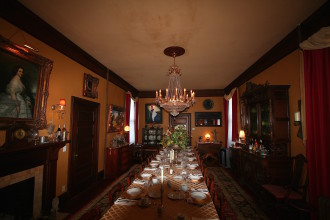
Asheville’s iconic destinations — places like the Biltmore Estate and the Grove Park Inn — have played host to a variety of influential figures over the course of their existence. Some of those figures, however, may have never left.
Reynolds Mansion, located in Woodfin, was built in 1847 by a team of 15 slaves for Daniel Reynolds and his wife, Susan Baird, according to the mansion’s current co-owner and caretaker, Billy Sanders.
“When we bought it, it was in really bad disrepair,” Sanders recalls. “It looked like a haunted house from a scary movie.”
Now a bed-and-breakfast, the mansion once hosted generations of senators, Asheville elites and members of the political Reynolds family until 1972. Politics and parties weren’t the only business conducted on the property, however.
“In 1920, Nathaniel Reynolds rented this house to the first female physician in Asheville, Dr. Elizabeth Smith. She ran Reynolds Mansion as an osteopathic sanitarium,” Sanders says. In addition, Reynolds, who also owned a funeral home in Asheville, was known to embalm “clients” from time to time at home.
The mansion has been the subject of several paranormal investigations by local ghost hunters, based on reports of two spirits haunting it: Annie Lee Reynolds, a spinster who suffered from either depression or tuberculosis, and another Reynolds’ daughter who died from typhoid fever at the age of 6.
“Usually you see [Annie Lee] on the staircase, or you’ll see orbs or [hear] a child’s voice,” Sanders says. “I never say anything, but many guests report similar experiences. That’s just part of living here — you learn to deal with it.”
Rather than be scared off by the ghosts that roam the mansion, Sanders says most guests are intrigued. “Guestroom Maggie was Annie Lee’s room; it’s probably the most haunted,” he reveals. “If somebody picks Guestroom Maggie, I try to move them, but most people will tell you that’s the room they wanted to stay in!”
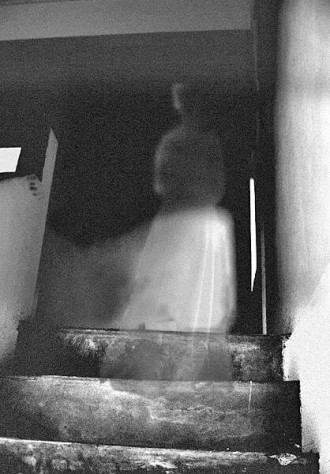
High-society haunting
The Grove Park Inn, meanwhile, can boast of having perhaps Asheville’s most famous spirit: The legend of the “Pink Lady” has inspired everything from ghost-hunting forays in the inn’s Palm Court to a special beer cocktail produced in collaboration by Grove Park Inn and Oskar Blues, according to Tracey Johnston-Crum, GPI’s director of public relations and community outreach.
“We do experience her a lot, and I mean a lot,” Johnston-Crum says of the inn’s resident phantom. “Predominantly in the colder months, or when there is construction.”
While stories of the Pink Lady’s presence and shenanigans around the inn abound, very little is known of her origins or identity.
“In 1920, a young woman fell, jumped or was pushed — we don’t know — from the fifth-floor balcony and lost her life,” Johnston-Crum reports. “She was rolled into a carpet and removed from the property — these things were stated in a manager’s log. She never signed in; there is no death certificate and no burial plot.”
Despite the mysterious circumstances surrounding her death, Johnston-Crum says that Grove Park’s apparition is benevolent, if a bit of a voyeur.
“The reason we call her the Pink Lady is that she tends to present herself as an orb of pink light or pink mist,” she notes. “She likes to [play pranks], and she really likes kids. Lots of our guests’ kids will say, ‘Mom, where did the nice lady go?’”
Raising the dead
Back at the Byrish, Warren’s seance has yielded some interesting new evidence. The mediums on hand overwhelmingly report a “strong masculine” presence in the establishment, electronic detection instruments whine erratically and a turn on the Ouija board reveals two mysterious letters: “O.H.” After some initial discussion, Pollock offers up a surprising tidbit of regional lore that makes Warren shake with excitement.
“Oliver Cromwell Hamilton, a wealthy magnate who came to Asheville with the railroad in the late 1800s, was the original owner of what is now the Sky Club,” Pollock reports. Little is known of Hamilton’s fate after the mid 1910s, he adds. “He’s never mentioned in tax records or local accounts [after that time], though his wife remained in the area for quite a while afterward. I haven’t been able to determine what became of him.”
Aside from the suspense, ghost tales can play an important role in sharing the region’s history. To that end, several organizations and tour companies in the area have developed programs and tours based around Asheville’s haunted past.
“As a kid, lots of people were afraid to discuss paranormal topics around here,” says Warren. “But, gradually, thanks to the media and people like myself who try to educate, I can honestly say the paranormal is, ironically, becoming ‘normal.’ There’s been a huge boom in Asheville’s attitude toward ghosts.”
Warren launched Haunted Asheville Ghost Tours in 1996, featuring a visit to the Asheville Mystery Museum, located in the basement of the Masonic Temple, where Warren houses artifacts related to the city’s legends and paranormal investigation equipment.
The Grey Line Trolley Tours company, meanwhile, utilizes the darker side of Asheville’s past to offer a different take on local history, says organizer Jonathan Helmpen.
“We have the information and training materials written by paranormal investigators of the Asheville Paranormal Society,” he says. “We [also] use the information that we have from our daily tour to give background information on what was going on in this time [or] what the town looked like [then].”
Similarly, the Swannanoa Valley Museum’s annual Historic Haunted House Tour takes advantage of the Halloween fervor to offer a unique look at important events and time periods in the region’s development.
“Whether the building we use for our ghost tour has a real ghost story or not, we fill the building with ‘spirits’ from the past,” says Tyson. “During the presentation these spirits reveal much about our local history and culture — what life was like when they were alive, what they wore, their place in their community and what made them interesting enough for us to bring them back to life.”
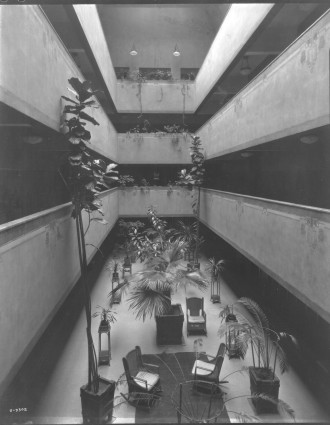
This year’s Historic Haunted House Tour will take place Friday, Oct. 28, and Saturday, Oct. 29, at the Round Knob Lodge near the Swannanoa Gap, where the railroad first crested the Southern Appalachians in 1879. Reservations can be made at history.swannanoavalleymuseum.org.
Spooky with a smile
Other tour companies take a more mischievous approach to Asheville’s ghostly legends. At LaZoom Bus Tours, attendees are treated to “all of Asheville’s gory lore, with a LaZoom twist, of course,” says co-owner Jennifer Lauzon. “Over the years our haunted tour has really gained a name for itself as a way to have fun exploring some of Asheville’s bloody and haunted past, in a lighthearted way.”
Despite the fun, Lauzon says that presenting Asheville’s history through the lens of ghost stories can serve as an important introduction to the region’s culture. “Sometimes we find history that has an edge, some drama or haunt, more interesting than the history that does not,” she notes. “If a bloody story sticks in the mind of citizens, and therefore provides them a deeper understanding of Asheville’s past, that’s a good thing.”
Dark Ride Tours, which celebrates its one-year anniversary this month, offers trips to Riverside Cemetery and several other locations in the back of a real-life, 1972 refurbished Cadillac hearse.
“The inside has part of a coffin in it that we got from a business on Riverside Drive,” says founder David Voyles, who also plays host as the character Virgil Nightshade. “We mounted a flat-screen TV on the coffin, where we can put some images up and play horror shorts. [The hearse has] got curtains and nice purple lighting, cameras and undercarriage lighting on the outside.”
While some of the tales he tells are based in history and local lore, Voyles notes that liberties are taken to create Dark Ride’s experience. “Our motto is stolen from Mark Twain: ‘Never let the truth get in the way of a good story,’” he laughs. “There’s some great tours out there that’ll tell you good folklore from the dark history of Asheville. You get some of that with me too, but sometimes, you’ll just have to look and see if there’s a twinkle in my eye.”
The dark side of dark tales
“One question I’ve encountered quite often is why there are no black ghosts,” says Payst. “The answer is because white people are, by and large, the ones telling the ghost stories, and the same pernicious problem of assuming that white, male and Christian is the default is extended even over the dead.”
Like the tragic tale of Gus Adler, two of Asheville’s most bloody tragedies — and their subsequent ghostly legends — feature often-overlooked racial components that highlight the tensions of a segregated city.
In November 1906, Asheville was rocked by a mass shooting committed by escaped convict Will Harris. When police responded to a domestic disturbance in the African-American neighborhood of Valley Street, known locally at the time as “Hell’s Half Acre,” Harris opened fire and fled the scene, leaving three civilians, two police officers and one unfortunate dog lying dead in the vicinity of Eagle Street and Biltmore Avenue.
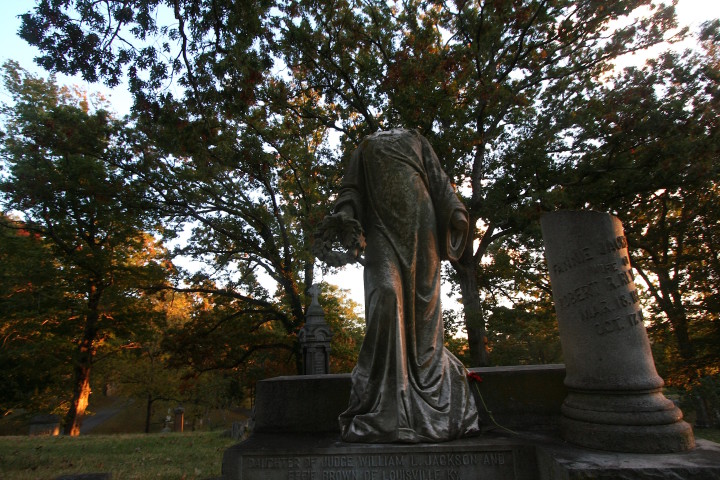
Asheville’s police chief at the time, Silas G. Bernard, reminisced on the murders and subsequent manhunt in a 1972 letter on file at Pack Library, calling it “the worst event that ever happened in Asheville.”
While the motives for Harris’ actions remain unknown, according to Bernard, Harris is said to have identified himself as “Ed Mills from Charlotte” before slaying a police officer in Pack Square. Mills had recently escaped from a state prison after being convicted of murdering a Charlotte policeman in similar fashion.
The massive manhunt that followed Harris’ spree ranged from Alexander to Fletcher, complete with bloodhounds, angry mobs demanding retribution and a final shootout in the woods outside Fletcher, where Harris was killed.
According to the Asheville Paranormal Society’s Sarah Harrison, apparitions of Harris’ victims can still be seen and heard along Eagle Street and in the vicinity of Barley’s Taproom, and employees at the taproom have reported voices, loud noises and poltergeist activity over the years.
The wrong man
Perhaps the most tragic case of murder and reprisal in Asheville’s history occurred at the Battery Park Hotel on July 17, 1936, when 19-year-old New York University student Helen Clevenger was found mutilated and murdered in room 224.
Pressured by the public to make an arrest, local police eventually accused a developmentally disabled African-American hotel employee, Martin Moore, even though he had no history of violence. While Moore initially confessed to the crime, he later recanted, claiming coercion.
An Aug. 23, 1936, article in the Chicago Tribune detailed Martin’s conviction and sentencing, noting that the jury deliberated for only an hour, despite Moore not fitting an eyewitness description of the fleeing suspect. The presiding judge declared it a fair trial and denied a motion to appeal. Moore was eventually put to death in a Raleigh gas chamber.
Current residents of Battery Park, now a Section 8 apartment complex predominantly for senior citizens, say that ghostly echoes of Clevenger’s death and Moore’s wrongful conviction continue to reverberate through the building.
Resident Carol Hubbard reports that strange noises and angry voices are a common occurrence around the building. “I think her ghost, Helen’s, is here, [and] I wouldn’t be at all surprised if the man who was wrongly executed for her death is hanging around here too.”
Lessons from the lore
While these ghost stories and legends may seem like a bunch of hooey to some, Warren believes that the unexplained phenomena humans typically characterize as “ghosts” offer an important insight into humanity’s relationship with itself and the unknown that surrounds them.
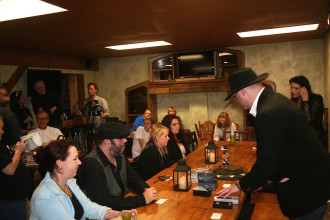
“Humans have a tendency to want to organize chaos,” he says after the seance, as participants gather to share their experiences and feelings from the ceremony. “But life isn’t that simple. Are these people’s experiences mass hysteria or delusion? Is it the paranormal? Who’s to say?”
For local historians such as Johnston-Crum, tales like that of Grove Park’s Pink Lady “ask people to step back in history, into 1920, and think what it must have been like to be a young girl,” she notes. “Maybe she was someone’s mistress; maybe she was just up here visiting — Grove Park was built as a place of respite; maybe this is the best place for the Pink Lady to find rest.”
Being able to play a role in the history of Reynolds Mansion and the spirits that may inhabit it, says Sanders, is a deeply personal honor for him. “You don’t really own something like this — you’re kind of just watching over it,” he says. “People ask me all the time if I’m scared to stay in here, but you know, I’ve never been scared. I find it fascinating.”
Whether one believes in spirits and ghosts, the events that spawn these local legends and the locations they inhabit have all contributed to making the city the one-of-a-kind place it is today.
“History is often presented as something stale and stagnant — just an old, lifeless black-and-white photo,” Warren says. “Ghost stories help transform history into something dynamic, still ‘living’ in some accessible form today. Whether or not a ghost story is true, it is an amazing tool for firing up the imagination and becoming emotional about the legacy of a place and what significant things occurred there.”
In the end, says Tyson, it’s that emotion and sense of mystery that continue to make these tales and legends appealing to people of all ages and beliefs. “Do werewolves and zombies exist, are ghosts real and can they hurt us? Do we really want to know the answer? Absolutely not.”



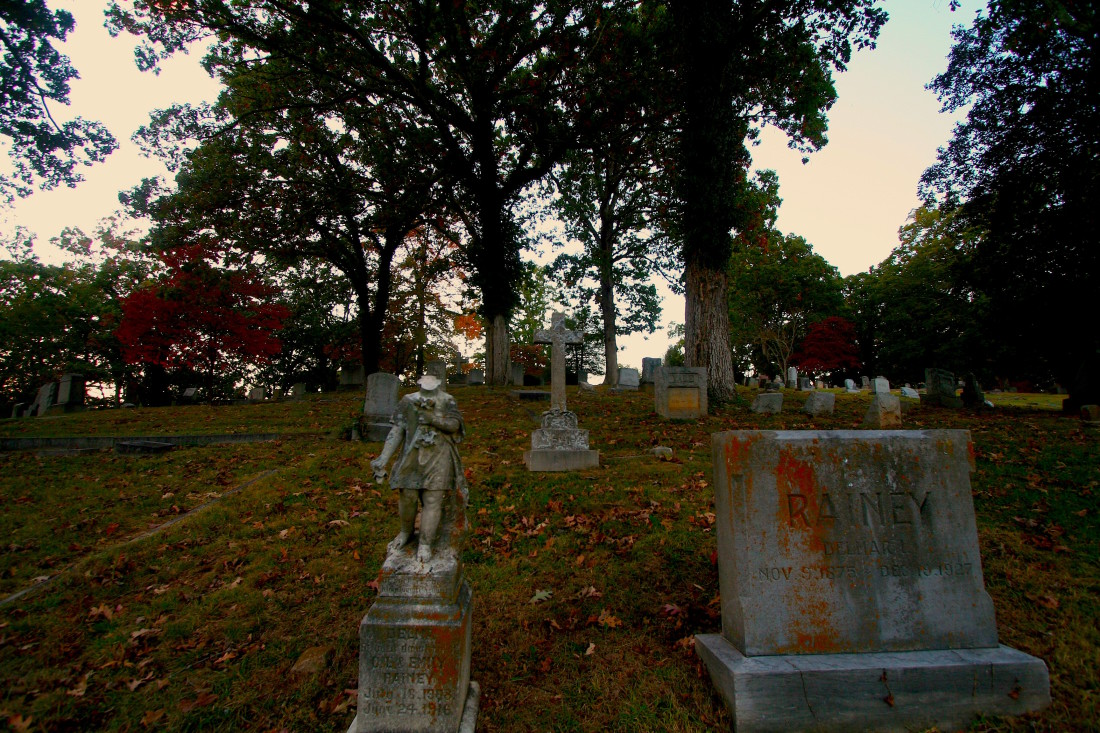
Awesome piece, Max!
Thanks Kim! I appreciate you taking the time to read it all. Glad you enjoyed it.
Ha, ha. Spiritually naive people who believe in the supernatural and try to pawn it off as a means to get people to visit their places. OOoohkay…
That’s the Halloween spirit….
posting time 5:47pm, Sat Oct. 29, 2016 AD.
I love how defensive of their fluff pieces Mtn X writers get when they post snarky posts online in order to justify, well, fluff.
I’ve noticed this trend with a wry smile for a number of years.
The writer of any Mtn X story has their chance to (hopefully objectively) express themselves for having ‘the floor’, and when any dissenting posts appear, the same writers act like posters with articulate opinions and not objective journalists. Edward R Murrow would be proud.
ApePeeD has a very valid point- The Mtn X will publish any frou frou woo woo new agey piece if it encourages readers spend money on ghost tours or buy someone’s book. Crystal worshipper lives (with money) matter, I suppose.
You caught me! Just working for the corporate ghost tour industry Illuminati — I’ll apologize to Mr. Murrow for my lack of professionalism at the next seance.
Mr. Hunt, I don’t think you’re being unprofessional or snarky – the Halloween spirit remark was concise – and quite appropriate (considering it was Halloween after all). And, as the Bard said “Brevity is the soul of wit.” For the record, I have never seen or heard anything much that couldn’t be fairly readily explained – but I am also not so arrogant as to claim I have all the answers – “There are more things in heaven and earth, Horatio….” (falling back on the old Swan of Avon again – same play!). If the ghost lore is a way of keeping local history alive and interesting for some folks – and if some positive financial fallout results, it is all to the good – and Will Harris, Silas Bernard, Helen Clevenger, the Adlers – all were real people who contributed in various ways to the history of Asheville and Buncombe County and some are buried locally, old homeplaces still stand, etc. I very much enjoyed your article and look forward to more!
Thank you for reading, Mr. Williams. Glad you enjoyed the article! It certainly was fun to research, and as you said, learn more about the people behind these stories and their impact on the community. As many of the folks I interviewed said in the article, whether one believes in “ghosts” or not, these tales and legends can be an interesting introduction to learning more about the events that have shaped one’s community.
With so many transplants (myself included) coming to the Asheville area, any avenue that offers newcomers a deeper view of the city’s past and historic landmarks is an important resource in my book.